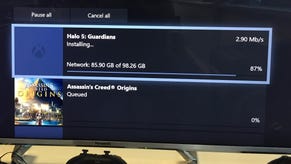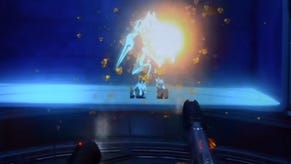Digital Foundry: Hands-on with the Halo 5 beta
Is 343 Industries on-track in delivering a true generational leap?
Ushering in the new year, the Halo 5: Guardians beta opens the gates to 343 Industries' rewritten Xbox One engine, its dedicated servers, and its strike out for full 60fps playback. The three-week sampler is very addictive as is, even with months of development left, showing a game that is recognisably still Halo at its core. But have the opportunities offered by the Xbox One hardware affected the gameplay balance from previous games at all - or is this all just about surface?
Map rotation is in its second phase now, leaving behind the industrial Empire and the covenant-themed Truth map (based on Halo 2's popular Midship) in favour of the arcade inspired Breakout, plus Regret and Eden. We've been playing the beta for a while now, so our focus for this piece is on the original two stages, but even with the new maps in play, it's clear that 343 Industries still has its laser-focus on 4v4 slayer games for the purposes of testing.
A close comparison with Halo 4 in its Master Chief Collection guise is illuminating. Although Halo 5's pace is improved by the addition of new moves, such as ledge-grabbing and mid-air boosts (bearing an uncanny similarity to Call of Duty: Advanced Warfare's agile controls), the technical advances behind the game are largely focused on the visual effects running over the top. On paper this is the least we can expect from an Xbox One rendition of Halo, but in practise it has a range of repercussions, both for better and worse.
Talking with The Guardian on the precise make-up of this new engine, development director Frank O'Connor calls this "a big reset in terms of the technology." However, there's no escaping the series' strong sense of legacy. "Some core principles of the gameplay and some familiar pieces of code are still going to be buried in there," O'Connor says, "but technologically, this is a whole new ball game and we're incredibly excited about it."
So what can we expect from the first truly new Halo game of the generation? Based on this beta, the visual progress from Halo 4 is largely brought by way of a new lighting model and screen-space effects, such as motion blur, ambient occlusion, bloom and lens flare. The blueprint set by Bungie's tenure is clearly kept in firm position beneath these extra layers though; Halo's idiosyncratic physics for jumping, grenade bounces and Spartan ragdolls still holding weight over the combat.
It's a missed opportunity to go all out - to press the reset button not just on the rendering tech, but on the core gameplay. However, the sense remains very much one of evolution rather than revolution. While it has tinkered with the combat move-set for the better, 343 Industries is seemingly opting for the safe road on the technical front, layering new effects over an otherwise familiar core design. On this trajectory, Halo 5 is set to fall into ranks with several major Xbox One and PS4 titles of the last year - such as Assassin's Creed Unity or FIFA 15 - where the new hardware is mostly used to bolster the visual sheen, rather than radically develop new gameplay ideas.
Even so, the changes to Halo 5's controls make this the most tightly handled, and immediately entertaining game in the series. The ability to clamber up ledges is especially invaluable for platform-packed stages like Breakout, and the ground pound move and smart scope each open up new attacking options. And sparing the largely unused slide move, each new ability compliments the action surprisingly well - though it'll be interesting to see how adeptly vehicles can now counter this faster on-foot pace.
Unfortunately, while there's some accomplished effects work at play in the Halo 5 beta, 343's choice to lock resolution at 720p for the beta draws unwelcome comparisons with existing titles in The Master Chief Collection. Resolution is just one element in terms of overall image quality, but as things stand, the 1080p remaster of Halo 4 is much easier on the eye - even shorn of its sequel's visual extras - and there are clear gameplay benefits too.
We're happy to have an open mind about final resolution choices, but the 1080p framebuffer employed in The Master Chief Collection exhibits clear advantages for a first person shooter where Halo 4's clean full HD output makes views across a large map like Ragnarok much clearer and useful to a player, for example. At the moment, there's no stage in Halo 5's beta rotation to match this incredible scope, but the glaring stair-step artefacts on the Breakout stage are already a clear sign that resolution is an issue that needs to be comprehensively addressed by release, ideally without pruning back the new engine's enhancements in the process. The question is to what extent 343 can up the pixel count without introducing the GPU as a bottleneck in the rendering process.
In terms of overall optimisation, there's still the best part of a year left to significantly improve matters before the Autumn release. In a series first, Halo 5 is launching with 60fps set as its target frame-rate from the get-go. It's an ambitious objective given the push for a visual overhaul too, and right now it mostly hits the mark. However, dips to the low end of 50fps are an issue with too many enemy Spartans on-screen - especially noticeable on the winding Regret stage. Meanwhile, tearing is introduced during these drops too, cutting into the top third of the screen, though hard to notice given that this is above its HUD (which, curiously, is also rendered at 720p).
That we're seeing frame-rate drops at all could be construed as a bit a of a worry, particularly given that we're only playing on medium-sized, vehicle-free, 4v4 slayer matches - where 16-player (or higher) big team battles are on the fans' checklist for the final product. Indeed, bearing in mind the 720p resolution, the appearance of any frame-rate problems at all is rather surprising. Well, in mitigation, it's important to stress that we are dealing with pre-production code here, and based on our observations, the idea that the GPU is to blame for the frame-rate dips may be off-beam.
Looking at the performance videos on a frame-by-frame basis, it seems that various glitches can kick in at any moment - and don't necessarily seem to be caused by intense GPU work. We'd hazard a guess that the artificial drop to 720p has indeed removed the graphics hardware as an obstacle to the game's target 60fps for the most part, and that other bottlenecks and glitches in the work-in-progress pipeline are causing many of the issues in the beta code. For example, we see frame-rate drops caused by even simple actions like reloading and walking immediately after a respawn. Even picking up a gun and firing for the first time can produce performance dips. Other times, drops occur on a seemingly random basis, with no visible evidence of what might be the cause. All of these issues should hopefully be resolved by launch.
As an aside, we also notice an interesting phenomenon with each map's opening cut-scene. These sequences pan across the major locales of the every stage, but show effects and geometry running at separate refreshes. Particles, alpha effects, and the lighting engine all render at 60fps in this case, but the character animations and camera update at around 30-40fps. It's a similar renderer de-sync to the one noticed in Diablo 3 on PS4 prior to its patch, where visual elements are updated independent of one another. Fortunately, in Halo 5 this only affects the opening cut-scenes, rather than actual gameplay.
In its current state, the fortunes of Halo 5's multiplayer mode feel somewhat mixed then - what's evident is that this is a fast, slick and hugely entertaining multiplayer experience, but bearing in mind the resources available to 343 (not least the potential scale and scope of the Azure cloud infrastructure), what feels missing right now is a genuine game-changer - a truly revolutionary multiplayer Halo experience. Of course, it's important to stress that this beta only shows a small selection of the eventual map suite, but even with the five maps shown so far, there are still plenty of unknowns surrounding the full product. The scale and number of the larger maps is a mystery, and the (very likely) remake of Blood Gulch could very well surprise us with improved LODs and textures compared to the Halo 4 version. The state of its single-player mode is also an enigma - and we hope the stutters seen on multiplayer mode intros aren't a sign of how story cinematics might unfold.
Without a doubt, the big positive is that Halo 5's controls are far more refined than ever before. Each rap of the boost button delivers a satisfying rush around a bend - and ups the tempo of mid-air shoot-outs too, without unraveling Halo's basic design too greatly. Used effectively in the Breakout mode, ducking and diving between cover spots is enormous fun. However, it's a change that could conceivably have been made to the series on Xbox 360, which begs the question: what difference does the Xbox One hardware make here?
As things stand, 343 Industries' efforts to show technical progress on Microsoft's latest console platform disappoint a little in this beta build. Given that it's the first Halo built just for Xbox One, the studio carries a huge weight of expectation in bringing a technical showcase to the console. Halo 5 must somehow go significantly further than the spruced-up, 1080p60 renditions of the existing titles we've already seen in the Master Chief Collection. However, despite some nice effects work, this beta does little to showcase the strengths of the new Xbox One engine - and we can't help but expect more bearing in mind that this technology is meant to mark a generational leap. The road to its final release is a long one though, and come launch it'll be fascinating to see to what extent this truly is a next-generation Halo title.

























